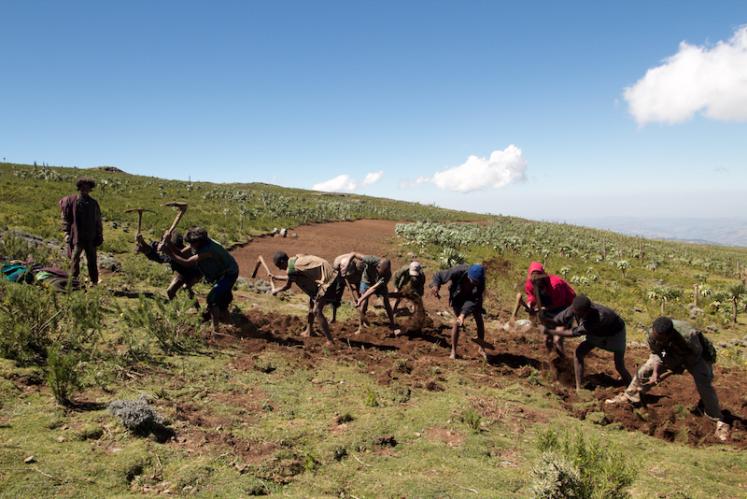Although the relationship between climate change and migration has interested researchers and policymakers for more than 25 years, migration continues to be perceived in overly simple terms – either as a successful livelihood diversification strategy or the outcome of a failure to adapt on the part of those who move.
There is growing evidence, however, that the picture is significantly more complicated. Even when people migrate for reasons related to climate change, political and economic structures, as well as social and cultural norms, play an important role in shaping migration decisions. This is reflected in migration patterns that follow routes established many years prior to the onset of rapid climate change.
Ethiopia is a particularly interesting country to study in this regard. Not only is it a country that experiences drought with varying levels of severity and frequency; it is also the second most populous country in Africa with unequal and highly politicized land tenure systems. Although the country is predominantly rural, it has one of the fastest urbanization rates in the world, reaching almost 5 per cent a year.
Research that is currently being undertaken in Ethiopia has found that climate-related migration is commonly practised by young smallholders who go to cities for temporary job opportunities as unskilled manual labourers during the off-farm season, mostly between November and February. The young smallholders confront different types of social and economic structural constraints between rural and urban spaces, and their movement options and patterns are sensitive to drought and its impacts on agricultural production.
To suggest that Ethiopia’s internal migration history is only a recent story related to climate change, however, conceals important structural issues and the aspirations of smallholders themselves. These factors often shape migration decisions and determine whether, when, and where young smallholders move. In particular, our research has identified two highly influential structural issues: rural land tenure systems and the urban environment.
The importance of understanding land tenure systems
Access to land is crucial for the livelihoods of smallholders. One of the major challenges facing Ethiopia is land scarcity and the rising number of landless young people in rural areas. Over the last 30 years, the population has more than doubled – from 50 to 120 million – and more than 70 per cent of the population is under the age of 29.
As Ethiopia’s population density has grown, household farm sizes have decreased substantially. More than half of the country’s rural farming households now cultivate less than one hectare of land. Young people in Ethiopia have historically relied on land inheritance to access land. However, as their prospects for land inheritance have dwindled, many have opted to leave their home villages for non-agricultural income activities or for further education in cities.
State ownership of land also affects migration decisions. Successive regimes stretching back to imperial times have maintained a policy of land nationalization. Rural smallholders have therefore accepted that their land holdings are not permanent property, but temporary allocations that could be reduced, or confiscated, at a moment’s notice. This dependence on the State has not only allowed the Government to maintain local power structures; it has also reduced land tenure security, convincing younger generations that they are left with no choice but to leave.
Strict State control over land tenure systems can influence mobility in other ways. Since land cannot be sold in Ethiopia, people are often discouraged from migrating permanently if they ‘own’ land; and if they decide to migrate, they often feel they have to leave family members behind, mostly wives and children, to look after the property.
The shift in migration patterns
Historically, the most common form of migration in Ethiopia was rural–rural as migrants searched for temporary job opportunities in large-scale commercial farms (for example sugarcane plantations) during the off-farm season. These farms were owned by the Government of Ethiopia or foreign companies in the Afar, Benishangul-Gumuz, and Gambella regions. Since the 2000s, however, migration patterns have shifted and are increasingly directed towards urban areas.
This shift has happened for two main reasons. Firstly, large-scale agriculture in Ethiopia is becoming an increasingly risky business due to climate change. Most cash crop farming, including sugarcane, is extractive and sensitive to shifts in temperature and rainfall. Severe droughts in 2011 and 2012 confirmed for many migrants that there were no longer many job opportunities available in rural areas.
Secondly, a series of ethnic conflicts persuaded migrants to avoid regions where they are obviously seen as outsiders; a trend that has become more prominent due to the country’s recent civil war. The most popular destination for migrants is currently Addis Ababa, which is a melting pot of diverse ethnic groups. Moving to Addis Ababa is seen as a lower-risk option than moving to other regional cities or previously popular large-scale farms.
The influence of the urban environment
Migration patterns and migrant experiences in Ethiopia are further shaped by the urban environment. While cities generally provide a wide range of employment opportunities, the limitations of citizenship, living conditions, and job security often generate structural barriers that restrict migrants’ mobility in a number of ways.
Firstly, there are bureaucratic barriers for migrants to obtain permanent legal residence in cities. Without an ID card, migrants are not legally recognized, and this affects their access to health and education services. Secondly, migrants tend to go to informal settlements upon arrival unless they have existing networks in cities. Living conditions, including hygiene, sanitation, and water availability in these informal settlements are often much worse than migrants’ rural homes. Finally, the informal labour market in cities is competitive because a limited number of jobs are available, particularly for non-skilled labourers. Female migrants often have higher job security in cities as they usually work as housemaids for urban households.
Implications for policy
Climate-related migration reflects the weak position of young smallholders embedded between rural and urban spaces and their vulnerability to recurrent drought events. Their migration only partly functions to spread risk, and in addition to climate change, also reflects land shortages and urban job opportunities. Moreover, migration is historically integrated into smallholder farming systems and is part of the seasonal farming cycle.
Young smallholders in Ethiopia need long-term policy support that considers larger structural issues. Firstly, land tenure security must be improved in the context of arable land scarcity, land nationalization, and recurrent droughts. Secondly, the informality and temporality of climate-related migration needs to be addressed in the urban policy context. Policy coherence is essential at the national level. Other policy areas, such as urban housing or rural development, also affect people’s mobility, and policies need to be designed in a manner that reduces regional and social inequality.
Suggested citation: "Climate-Related Migration Into Cities: Ethiopian Smallholders Heading to Addis Ababa," UNU-CPR (blog), 2023-03-03, https://unu.edu/cpr/blog-post/climate-related-migration-cities-ethiopian-smallholders-heading-addis-ababa.




